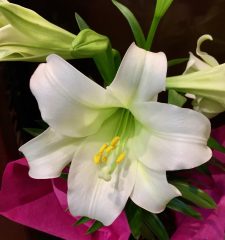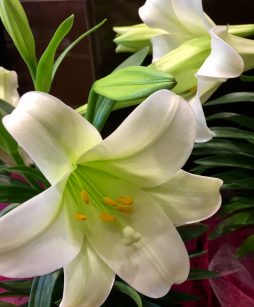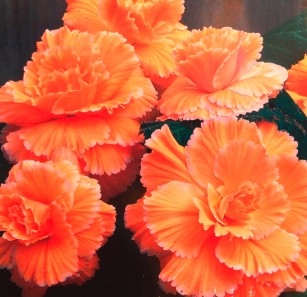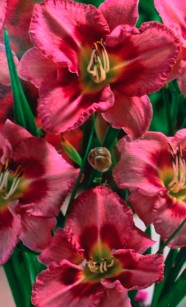Whether you observe Passover, Western or Eastern Christianity Easter when this time of year arrives I wait patiently for my Easter lilies to come up in the garden. The shoots are now about 6″ tall but they are a long way from blooming and I look forward to those huge, fragrant, white trumpet-shaped flowers. I pick up a few new blooming plants each year to enjoy now and celebrate Easter. It’s a tradition that marks spring along with decorating eggs, chocolate bunnies and Easter baskets.

Easter lilies that are blooming at his time of year have been forced under controlled conditions to flower in time for Easter. This is a very tricky process since Easter falls on a different day each year dependent upon celestial bodies. Falling on the first Sunday that follows the first full moon after the vernal equinox, Easter can be any day between March 22 and April 25. Crop scheduling and timing is critical. The flowers must bloom exactly when they’re suppose to with no margin for error.
Did you know that over 95% of all the bulbs grown for the Easter lily market are produced by just 10 farms in a narrow coastal region straddling the California-Oregon border? Known as the Easter Lily Capitol of the World, the area offers a climate of year-round mild temperatures, deep, rich alluvial soils and abundant rainfall which produces a consistent high quality bulb crop.
The Easter lily or Lilium longiforum, is native to the southern islands of Japan where it was grown and exported to the US until WW ll. When the Japanese attacked Pearl Harbor in 1941 the Japanese source of bulbs was abruptly cut off. As a result, the value of lily bulbs sky-rocketed and many who were growing lilies as a hobby here decided to go into business. The Easter lily bulbs at the time were called ‘White Gold’ and growers everywhere attempted to cash in on the crop. By 1945, there were about 1,200 growers producing bulbs up and down the Pacific coast from Vancouver to Long Beach. But producing quality, consistent lily bulbs proved to be quite demanding with specific climatic requirements. Over the years, the number of bulb producers dwindled to just the 10 current farms near the Oregon border. Even after the Japanese started to ship bulbs again after the war, they have never been able to come close to the quality of our US grown bulbs.

Here’s how to make your Easter lily continue to thrive in your garden. For the longest possible period of enjoyment, remove the yellow anthers from the flowers before the pollen starts to shed. This gives longer flower life and prevents the pollen from staining the white flowers. Place the plants in bright indirect daylight, not direct sunlight, and water when the soil surface feels dry to the touch. Do not let the plant sit in water.
After blooming, plant your lily outside in sun or part shade after letting it acclimate to brighter conditions for a week or so before transplanting. Plant in a well-drained garden bed that has been amended with lots of organic matter like compost and mulch the surface with more compost. As the original plant begins to die back, cut the stems back to the soil surface. New growth will soon emerge but go dormant again during the winter. Next year they will bloom naturally in the early summer.
Easter lilies are a great addition to the flower border. Easy to grow, fragrant and hardy.


